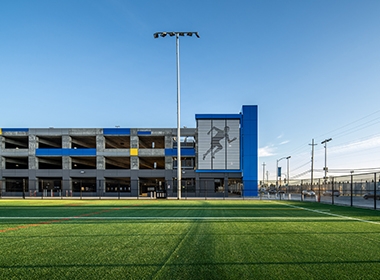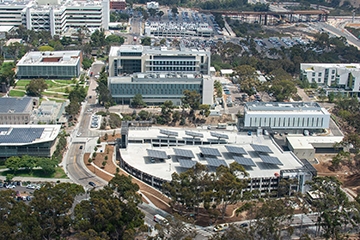Every college campus has a unique history and identity, from school colors and mascots to athletic teams and community ties, and every building on campus has an opportunity to contribute to that rich heritage. Recognizing that parking is often the first and last experience a person has when traveling to a college campus, many universities have taken the opportunity to transform parking into a welcoming celebration of identity that sets the tone for the overall campus experience.
 Replaceable banners along the façade of the Sierra College Rocklin Parking Structure provide an opportunity to showcase school spirit.
Replaceable banners along the façade of the Sierra College Rocklin Parking Structure provide an opportunity to showcase school spirit.
A Lasting Initial Impression
Parking structures offer a unique opportunity for universities to make a lasting initial impression, such as an architectural statement championing school spirit. This can come in the form of colorful facades showcasing school colors, public art and unifying architectural elements that connect parking to the surrounding campus. Flexibility can also be designed into parking facility facades to allow universities the opportunity to customize their message.
Replaceable banners are featured prominently along the façade of the Sierra College’s Rocklin Campus Parking Structure. In addition to providing architectural interest, each banner serves as a creative canvas that can be customized to celebrate events, seasons and welcome visitors to campus.
At UC Riverside, the design of the Big Springs 2 parking structure features an iconic tower branded with university colors. A unifying "blue ribbon" encapsulates the elevator tower and acts as a consistent element throughout the facade, while also creating an architectural connection to other buildings on campus.
 The Gateway Parking Structure at University of Nevada, Reno will feature a brick façade that connects to the existing campus and a pedestrian bridge that honors Reno's ties to the railroad.
The Gateway Parking Structure at University of Nevada, Reno will feature a brick façade that connects to the existing campus and a pedestrian bridge that honors Reno's ties to the railroad.
As the Gateway Precinct expansion at University of Nevada, Reno will serve as a connection between both the existing campus and downtown Reno, the new Gateway Parking Structure will honor both. The façade will feature the rich brick finish found throughout the campus, while design of a prominent pedestrian bridge will reflect Reno’s deep ties to the railroad, including exposed trusses to evoke a historic railway bridge, and a train-inspired curved roof.
School colors and complementary architecture are not the only ways a parking structure can reinforce university identity. As UC San Diego is closely knitted to its landscape, the university wished to integrate the Osler Parking Structure within the surrounding historic eucalyptus grove. Therefore, the façade system features a multilayered system with custom-designed panels that emulate the trunks of the eucalyptus trees. The panels capture and transform the varied shadows of the adjacent trees and cast them onto the concrete. This creates an additional level of abstraction that physically screens the structure and provides the appearance of the randomness of nature in the surrounding grove.
 The South Campus Parking Structure at San Jose State University celebrates a rich history with track and field through artistic shadow renderings of photos from the "Speed City" era.
The South Campus Parking Structure at San Jose State University celebrates a rich history with track and field through artistic shadow renderings of photos from the "Speed City" era.
Honoring Athletes
Sporting events are an integral part of many university identities, and parking facilities can provide an opportunity to create a meaningful connection to college athletics.
Honoring “Speed City” athletes and their legendary track and field coach, Bud Winter, was an important component of the South Campus Parking Structure at San Jose State University. A two-acre playing field featuring a state of the art synthetic turf surface was designed adjacent to the parking structure. A dedicated walkway circles the field that is open to the general public, further integrating the facility into the community. As the structure serves spectators for athletic events in addition to students and faculty, extra measures were included in design to elevate the user experience, including restrooms. To better accommodate large numbers of people entering and exiting at the same time, the structure was designed with a cascading double express ramp.
The parking facility itself pays homage to the legacy of SJSU athletes. The façade bears the University’s yellow and blue colors, utilizing bent and flat metal to simulate movement and speed, and the elevator towers feature artistic shadow renditions of original photos from the "Speed City" era.
College athletics also feature prominently on a parking structure at American River College. The structure is adorned with a larger-than-life art installation featuring the college’s own football, tennis, baseball and track stars in action. Taking the form of three 30’ x 30’ durable, nylon fabric panels, the artwork literally provides a backdrop to the adjacent Athletic Center and enhances the architectural connection between it and the parking structure while showcasing campus culture.
For many universities, parking serves as a gateway to the rest of campus, providing a unique opportunity to celebrate their rich history and create a lasting positive impression.







